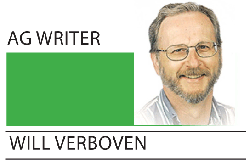A recent road trip saw your inquisitive columnist and his patient wife chance upon the Idaho Potato Museum in Blackfoot, Idaho. What a charming discovery; who would have suspected it contained the world’s largest collection of potato mashers, french fry cutters, and potato peelers, including dangerous-looking electric ones. What was an eye-opener was learning about the development of a small local farming enterprise into the world’s most concentrated potato-growing and processing mega industries. One notes that Idaho state license plates feature the slogan “Famous Potatoes,” and they aren’t kidding. The southern part of this state has 300,000 acres in production, producing an estimated 1 billion spuds annually. That’s around 25% of US production; add in adjacent Washington state production, and those two states grow close to half of all American potatoes.
That’s a lot of production compared to Canada – where national potato acreage is around 390,000, with 80,000 in Alberta. Alberta recently became the largest potato producer, surpassing Manitoba and PEI. The latter province markets its fresh potatoes as being better due to its red sandy soil. Idaho claims its spuds are better because they are grown in volcanic soils. Be that as it may, most spuds nowadays are processed into french fries and potato chips, where potato variety is more important than where they are grown. In the early days, most potatoes were marketed into the fresh market or freeze-dried into flakes for instant mashed potatoes.
Some of the big processors have developed their own proprietary potato varieties to improve the products they produce. For instance potato chip processors have developed a rounder potato to improve chip size processing and with less sugar content to reduce dark chips. As expected, the Idaho potato growing area is home to the biggest potato processors in the world like McCains, Lamb Weston, Lays and Simplot. The latter is a family operation that includes 82,000 acres of potato land. At one time, they shipped 10,000 railway boxcars of potatoes all over the USA. They are also famous for a deal they made with MacDonalds in 1973 to make them their largest supplier of french fries in the USA.
The french fry processing business is based primarily on the Russet Burbank (also called netted gem) variety of potato. It’s a long, elongated spud that is ideal for french fries. That potato and its variations are also the main variety used in Alberta potato production. At McDonald’s insistence, and they are the big dog buyer, no GMO potatoes are grown. There is no basis in science for that demand; it’s strictly a PR marketing strategy. The naïve consumer would be unaware that a perfectly safe GMO potato would reduce the use of millions of tons of pesticides and herbicides worldwide. But I digress. The Potato Museum precisely portrays the evolution of potato planting and harvesting over the past 100 years. In the early days, potato farming was a back-breaking business that was very labour-intensive. Machinery was rudimentary at best and saw potatoes being graded and bagged by hand in the field and later being loaded by hand onto railway cars. That restricted any significant expansion of potato growing, but relief was on the way as clever inventors and engineers designed ever more efficient large-scale planting and harvesting machinery. Today, commercial potato growers in North America are high-tech leaders using computer-image grading, fully automated handling and drones for disease and pest detection.
One cute display in the museum featured the world’s largest potato crisp (a pringle chip). As admirable as that was, it twists the unfortunate reality that the USA, from personal testing experience, cannot produce a superior, flavourful potato chip. That honour goes to Miss Vickies original potato chips made right here in Taber, Alberta. It boggles the mind that as sophisticated as the US is in food science and competitive product development, it cannot create the best potato chip in the world. To be fair, the potato chip world is dominated by the giant American Frito-Lay global snacks empire, which also produces the legendary Miss Vickie chips from Canada. I expect in time that superior chip will take over the world.
Finally, the Potato Museum had an attached potato restaurant which cooked up perhaps the finest french fries I had ever tasted outside of iconic MacDonalds fries. It was a good day at the Idaho Potato Museum, much better than the inferior french fry museum in pompous Bruges, Belgium. Will Verboven is an ag opinion writer and enthusiastic french fry and potato chip consumer.
Will Verboven is an ag opinion writer.
Welcome!Log into your account









